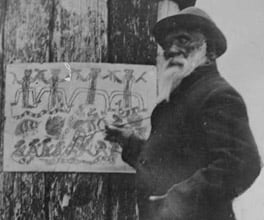Artist William Barak
Wiliam Barak was an Aboriginal artist and an important cultural leader for Victoria's Indigenous community. After Simon Wonga died in 1875, he took on the struggle to keep the land at Coranderrk. He also worked hard to keep the local Indigenous customs and stories alive throughout his life.
At Coranderrk, where Indigenous ceremonies and corroborees were banned, Barak used his paintings to teach and lead his people, passing on what he knew of Aboriginal history, religion and customs.
His art also showed Europeans the complexity and importance of his peoples' cultural and spiritual life. Barak combined traditional Indigenous materials – like ochre and charcoal – with European techniques and manufactured paints. He was one of the few Indigenous artists in the 19th century who welcomed the chance to experiment with new materials:
His brush and his colours were crude, the colours being pigments from the earth. Notwithstanding this, some of his pictures are to be seen in the museums of Europe.
– Anne Fraser Bon, quoted in The Argus, November 28 1931
Sayers, A 1994, Aboriginal artists of the nineteenth century, Oxford University Press in association with the National Gallery of Australia, Melbourne, Vic.
Although Anne Bon was a friend of Barak's, her use of the biased word ‘crude' suggests that materials used in Indigenous art were considered primitive by Europeans at the time.
Barak only painted Aboriginal scenes depicting sacred ceremonies and spiritual stories unique to his people. He focused on two aspects of traditional life: corroborees, and groups of Indigenous people wearing possum-skin cloaks which identified them as Wurundjeri.
Barak's focus on corroborees allowed him to show Indigenous and non-Indigenous people how these ceremonies took place. In 1887, the Victorian Governor, Sir Henry Locke, asked to see a corroboree but the Aboriginal Protection Board wouldn't allow it.
Instead, the Governor was given one of Barak's paintings of a corroboree, which art historian, Anne Fraser Bon claims: 'the Governor accepted and placed on the walls beside pictures by the old masters.'
Barak is one of many Aboriginal artists – including Tommy McRae – who used his artwork to help non-Indigenous people better understand and respect Aborigines and their way of life. But for the people of Coranderrk, Barak's art was also a particularly important link with their culture.











